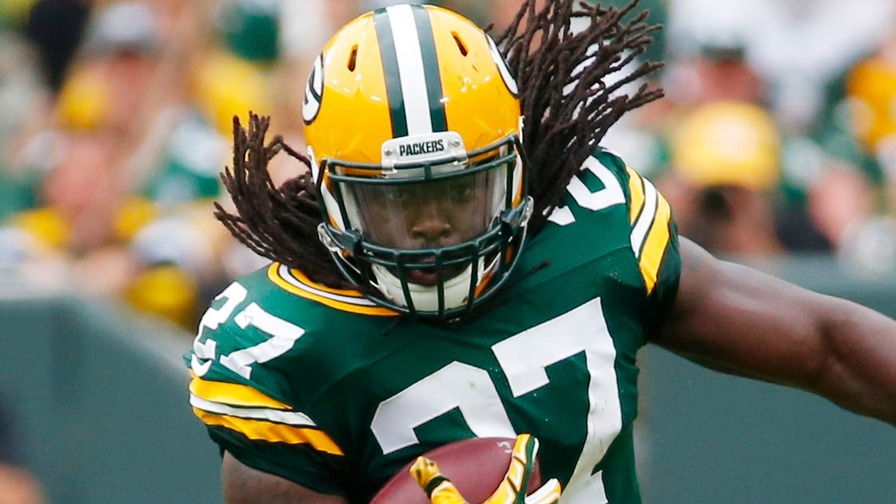Eddie Lacy Is Worth the Risk for the Seattle Seahawks

The Seattle Seahawks have bulked up their run game, and instead of doing that by bringing in an offensive lineman, they've accomplished it by signing running back Eddie Lacy on a one-year deal.
Since the start of the Russell Wilson era, the Seahawks have been a team built around the running game. That was expected to switch last season -- and it did -- with the retirement of Marshawn Lynch, but some of that was due to ineffectiveness instead of a philosophical switch to more passing.
By our Net Expected Points (NEP) metric, the Seahawks had a bottom-third running game last season. They ranked 23rd in Adjusted Rushing NEP per play while having the 18th-most run-heavy offense. For comparison's sake, they had the fourth-most run-heavy team and ranked sixth in Adjusted Rushing NEP per play when they reached the Super Bowl the prior year.
Even with more trust and responsibility for Wilson at quarterback, the Seahawks still want to run the ball down the throats of opponents. They just couldn’t do that consistently during the 2016 season and the offense struggled. It’s a reason why they planned a free-agent visit parade of veteran running backs before deciding on Lacy.
Signing Lacy doesn’t come without risk -- that's why the 27-year-old only got a one-year deal -- but for the Seahawks, it should be worth it.
Carrying the Weight
Inevitably, any conversation about Lacy is going to touch upon his weight at some point, and it’s a fair concern. Over the past few seasons, Green Bay Packers head coach Mike McCarthy reportedly fined Lacy for being overweight, though no specific details are mentioned.
Then, there’s this report from Bob McGinn of the Milwaukee Journal-Sentinel shortly after the signing was announced.
RB Eddie Lacy visited Sea (his new team), Minn and GB in the last wk. For one of the three teams Lacy weighed 267. Listed last year at 234.
— Bob McGinn (@BobMcGinn) March 14, 2017
Listed weights shouldn’t be taken as gospel, but weighing in at 267 pounds is staggering, even when considering Lacy is still recovering from an ankle injury. Remember, Leonard Fournette was considered a “big†back when he weighed 240 pounds at the NFL Combine.
Regardless of Lacy's 2016 playing weight, he performed quite well before his injury. He ranked 10th in Rushing NEP per attempt among the 60 running backs who carried the ball at least 70 times. However, it should be noted that despite the favorable efficiency ranking, he came in 29th among those backs in Success Rate, which is the percentage of plays that positively impact NEP.
What's interesting is that his performance was the exact opposite in 2015 -- among 44 running backs with 100-plus carries, he ranked 28th in Rushing NEP per attempt, but 9th in Success Rate.
The 2017 season would be a good time for him to blend the best parts about each of his performances from the last two seasons.
Running With Friends
The questions surrounding Lacy have to do with with durability, something that may be quelled with throwing him into Seattle's current stable of backs.
It’s been a year or two since his last effective season as a workhorse, but that shouldn’t be his role with the Seahawks since they have two other running backs in Thomas Rawls and C.J. Prosise -- three if you want to count Alex Collins -- who will give Lacy support in the backfield. Neither of the backs performed up to expectations in 2016 due to injuries, but there’s certainly reason to be optimistic about production going forward.
Rawls was one of the league’s most inefficient backs last season as he battled through multiple leg injuries, ranking 37th of 42 running backs with 100-plus carries in Rushing NEP per attempt. But that did come just a season after he ranked second in the very same metric.
Prosise only got 30 carries before a shoulder injury, and before getting hurt, he was continually gaining responsibility and market share in the offense. If he sustained his 0.04 Rushing NEP per play over 100 carries, he would've been around the top-10 running backs in the league. He was more of a threat in the passing game, though, where he had a Reception NEP per Target of 0.91 (17 catches on 19 targets).
A Worthy Gamble
All three of these backs come with some injury risk, but Seattle will be hoping that not all are sidelined at the same time. It’s also possible the Seahawks aren’t done adding to this group. While Adrian Peterson left Seattle without a contract before Lacy came in, Jamaal Charles is still scheduled to visit the team on Wednesday even after this agreement.
Only $3 million of Lacy’s deal is guaranteed, with the other $2.5 million likely earned with incentives. That places him in the mid-range of running back contracts, which isn’t bad considering the Seahawks will only allocate $1.36 million of 2017 cap space between Prosise and Rawls, per Over The Cap.
When healthy, all three can be effective parts of a successful run game. Health is going to be the biggest question, but for what the Seahawks are paying, the potential benefit outweighs the risk.
















